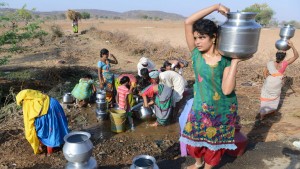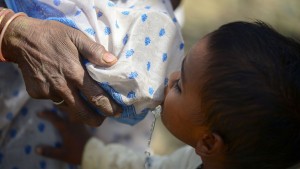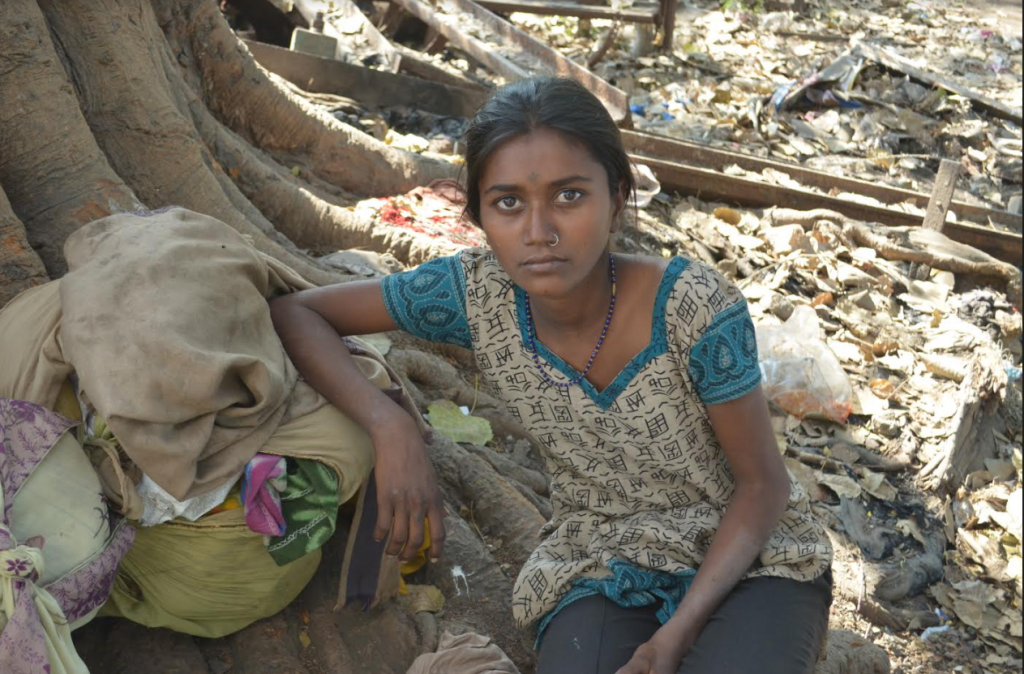Women battle tough times in drought-hit India

An indian woman walks on a dried and cracked water pond as she carries bucket to take drinking water. © Imago/Zuma Press
In the baking sun and swirling dust, Madhu, 37, looks dejected as she surveys the parched field of kharif paddy and pulse crops in Hamirpur in the northern state of Uttar Pradesh.
I can clearly understand that the killer heat wave is leaving the country reeling from the worst drought in decades and a rural population struggling to survive.
The monsoons are still far away but Madhu dreads the summer. This, because two years of consecutive drought and crop loss has forced her family to take three loans, hive off part of the family’s 3 acre holding , and driven her husband, Manoj Gautam to do menial labor.
“This is a living hell. Our cattle is dying too as there is no fodder. Who will help us? And I walk 3 kms to fetch water”, laments Madhu.
Her words carry resonance.
In the sprawling drought-ravaged Bundelkhand region of Uttar Pradesh, thousands of villages have been hit since the last 19 months. Not only that, thirteen districts in India’s most populous state have been affected.

Indian Lambadi tribal villagers fill drinking water from a leaking pipe on a roadside at Chandampet Mandal in Nalgonda east of Hyderabad on April 25, 2016, in the southern Indian state of Telangana. © AFP/Noah SEELAM
It is evident that farmers and villagers are going through difficult times. And in most cases in the rural hinterland, women, I understand, become the backbone of drought-hit families, managing to provide better than subsistence-level incomes in the face of farm losses.
Clearly, women are the most vulnerable during drought because it is their duty to fetch water and provide food for the family.
The region has already recorded a number of suicides and starvation deaths.
In an adjacent village, Dhanu says the sheer business of living has become a game of survival.
“Not only do womenfolk have to collect water from wells traversing huge distances daily, but also have to cope with the emotional stress of putting out a decent meal for the family when there’s no money at home”, she exclaims.
Her neighbor, Sohini agrees.
“We always have to bear the brunt of a disaster. Somehow fight, haggle to see that the family lives through the day”, she says.
According to 2011 census poll, more than half of Indian households did not have a source of drinking water at home – 63 percent in rural India – and a fifth of rural households walked more than 500 meters to get drinking water.
The lives of women start early. They trudge distances that take more than an hour, carrying earthen clay pots and sometimes buckets which they delicately balance. In addition, they spend time waiting their turn. Sometimes, fight break out at water pumps.
And sometimes Dalit women, the so-called lower caste in India’s caste hierarchy have to face another hurdle in these excruciating times. Sometimes they are denied access to water by upper caste people.
That is why a Dalit labourer from a village in Washim district of Maharashtra’s drought-hit Vidarbha toiled for hours to dig his own well. The wife of Bapurao Tajne, a resident of Kolambeshwar village in Malegaon, was not allowed to fetch water from a well by villagers.

An Indian woman tries to filter polluted well water with her sari as a child drinks during a water crisis in the Shankargarh area, 45km away from Allahabad, on April 21, 2016. © SANJAY KANOJIA/AFP/Getty Images
In a bid to take his revenge on a social milieu which still discriminates large sections of people, Tajne took it upon himself to dig a well in his village, and is quenching the thirst of the entire Dalit population of the area now.
While water is scarce, another scary development is unfolding as distress migration happens.
Hundreds of farmers are fleeing the drought-stricken districts of Bundelkhand this year, and have sought work as manual labourers in cities such as Indore, Mumbai or Delhi for work and money.
And as a result, while men folk are migrating in search of food and jobs, they leave their women, children and older family members behind and vulnerable to human traffickers.
“Yes, it is scary. We heard from other villages that some children were abducted. That is why it is difficult to even sleep thinking of the family’s security”, adds Sohini.
I did not come across any specific cases, but the fear and threat is real in the region.
While the situation is bad in Uttar Pradesh, nearly 9 million farmers in the western state of Maharashtra have been impacted by the drought that has devastated the kharif crop, which is soon in the monsoon.
The state is already known for its farm crisis and reports the highest number of farmers’ suicides in the country.
It has impacted mainly the Marathwada and Vidarbha regions. These areas have historically been the most deprived in the state.
Women are clearly taking the brunt.
Author: Murali Krishnan
Editor: Marjory Linardy
_____
WTO RECOMMENDS
Religious intolerance in India: Tough times mostly for women
These are difficult and troubled times in India. What began as a trickle of protests has now assumed huge torrents. A number of Indian authors have returned their literary awards to protest against rising religious intolerance in the country. (From November 27, 2015)
Atrocities on women in India: ‘It’s not just a gender problem.’
In the backdrop of the numerous reported cases of rapes, gang rapes and widely visible discrimination against women in India, the German author, artist and social worker Dr. Katharina Poggendorf-Kakar spoke about the India-specific form of such violent acts. Dr. Poggendorf has lived in India since 2003 and travelled extensively through India to understand the basis of such atrocities on women. (From July 14, 2015)






